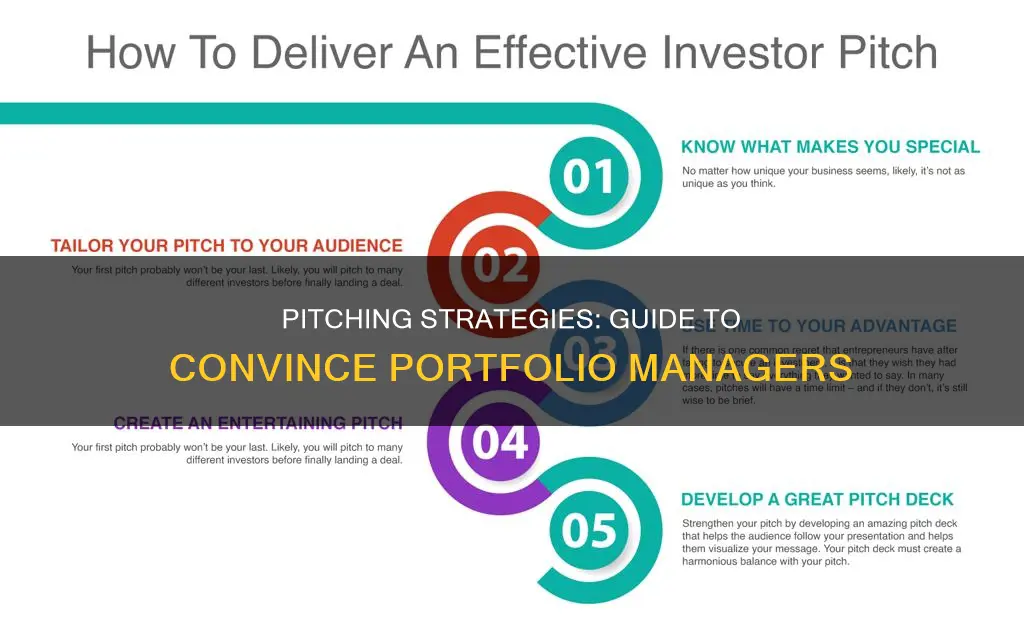
Pitching an investment strategy to a portfolio manager can be a daunting task, but with the right approach and preparation, you can increase your chances of success. Here are some key considerations to help you craft a compelling pitch:
- Know your audience: Understand the portfolio manager's investment style, goals, and preferences. Tailor your pitch to their specific interests and objectives.
- Clear and concise message: Focus on delivering a clear and concise message that highlights the key strengths of your investment strategy. Lead with an elevator pitch and emphasize your value proposition throughout your presentation.
- Interactive and engaging: Make your pitch interactive by involving the portfolio manager and their team in the conversation. Instead of relying solely on prepared comments, encourage a dynamic Q&A session to showcase your knowledge and expertise.
- Interesting and unique message: Avoid generic explanations and provide specific examples to illustrate your investment process. Share your unique approach and showcase your ability to identify and evaluate investment opportunities.
- Practice and improve: Understand the importance of practice and continuous improvement. Regularly review your pitch, seek feedback, and work on enhancing your presentation skills, including your body language and non-verbal cues.
- Showcase your team: Highlight the strengths and expertise of your team. Introduce the key members who will be involved in implementing the investment strategy, demonstrating the capabilities and experience they bring to the table.
- Demonstrate differentiation: Clearly articulate how your investment strategy differs from others in the market. Explain the factors that give your approach a competitive edge, whether it's your unique investment thesis, catalysts, or risk management techniques.
- Provide data and evidence: Support your claims and assumptions with robust data and evidence. Include relevant metrics, financial projections, and market research to back up your investment strategy and show that it is grounded in facts and analysis.
- Risk assessment and mitigation: Be transparent about the risks associated with your investment strategy and explain how you plan to mitigate them. Address the potential challenges and present a well-thought-out plan to navigate those risks effectively.
- Call to action: Clearly state your funding requirements and how you intend to utilize the resources. Be specific about the amount of investment needed and outline the expected outcomes and benefits for the portfolio manager and their clients.
| Characteristics | Values |
|---|---|
| Message | Clear, concise, and interesting |
| Preparation | Research, practice, and refine |
| Content | Introduction, problem, solution, product preview, market research, competitor analysis, and core analytics |
| Delivery | Confident, engaging, and interactive |
| Team | Highlight the team behind the product |
| Differentiation | Highlight unique aspects and value proposition |
| Traction | Demonstrate proof of concept and market interest |
| Investment Thesis | Explain why the stock is a good investment |
| Data and Analysis | Support claims with data, facts, and analysis |
| Risk Assessment | Identify and address potential risks |
| Call to Action | Clearly state funding requirements and intended use |
What You'll Learn
- Elevator pitch: introduce yourself, your product, and your value proposition
- Know your audience: tailor your pitch to the portfolio manager's interests and expertise
- Show your worth: demonstrate the market opportunity and your product's unique value
- Be engaging: make your pitch interactive and dynamic to hold their attention
- Back it up: support your pitch with data, facts, and figures

Elevator pitch: introduce yourself, your product, and your value proposition
Hi, my name is [Name], and I am an investment advisor with [Number] years of experience in the industry. I am passionate about helping individuals and businesses achieve their financial goals and maximize their investment potential.
Today, I want to introduce you to our investment strategy, which we believe will revolutionize the way you approach the market. Our strategy is centered around the idea of [Briefly describe your unique investment strategy]. This approach allows us to [Explain the benefits of your strategy and how it differs from traditional methods] .
For example, we recently worked with a client who was looking to [Client's goal]. By utilizing our strategy, we were able to achieve [Outcome of the investment strategy for the client]. Not only did we help them [Explain how the client benefited], but we also [Additional benefits the client experienced].
Our investment strategy is designed to be flexible and adaptable, ensuring that we can tailor our approach to each client's unique needs and goals.
In addition to our unique strategy, we also offer a comprehensive suite of services, including [List the services you provide as part of your investment strategy]. We believe in transparency and keeping our clients informed every step of the way. Our team of experts is dedicated to providing the highest level of service and support, ensuring that our clients feel confident and empowered in their investment decisions.
We invite you to join us on this journey and experience the power of our investment strategy. Together, we can navigate the complex world of investments and work towards achieving your financial aspirations.
Retirement Planning: Fisher's 500K Portfolio Breakdown
You may want to see also

Know your audience: tailor your pitch to the portfolio manager's interests and expertise
Knowing your audience is a crucial aspect of pitching an investment strategy to a portfolio manager. Here are some detailed tips to tailor your pitch to the portfolio manager's interests and expertise:
Research the Portfolio Manager
First, understand the portfolio manager's goals, needs, and preferences. Identify their pain points and challenges, and tailor your pitch to address these issues. Create a profile of the portfolio manager, including their demographics, interests, and professional needs. This will help you customise your pitch to match their expectations.
Understand their Level of Expertise
Gauge the portfolio manager's familiarity with your product, market, and industry. This will help you adjust the level of detail, complexity, and jargon in your pitch. Use analogies and simple language to build reliability and clarity around difficult concepts. Respect their time and always express gratitude for their attention.
Highlight Relevant Projects
Choose projects that align with the portfolio manager's interests and showcase your skills and expertise in those areas. For example, if the portfolio manager specialises in a particular sector, such as healthcare, tailor your pitch to focus on healthcare-related projects. Demonstrate how your projects solve specific problems and showcase the outcomes and benefits.
Use Storytelling Techniques
Craft a compelling narrative that connects with the portfolio manager. Storytelling can make your pitch more engaging and memorable. Share your journey, including how you came up with your investment strategy and why you are devoted to it. Describe the target audience, the problem it faces, and why your solution is necessary. Bring up relatable examples and facts to support your pitch.
Emphasise Visuals and Data
Use visuals, such as images, charts, graphs, and videos, to illustrate your investment strategy in action. Ensure that any visuals are clear, high-quality, and easy to understand. Support your pitch with data, including market research, realistic projections, and competitor analysis. This will help validate your assumptions and demonstrate the potential of your investment strategy.
Diversifying Your Portfolio: Optimal Number of Investments
You may want to see also

Show your worth: demonstrate the market opportunity and your product's unique value
When pitching an investment strategy to a portfolio manager, it's essential to demonstrate the market opportunity and your product's unique value. Here are some detailed tips to help you showcase your worth effectively:
Demonstrate a Deep Understanding of the Market:
- Size of the Market: Convey the size of the market and its growth potential. Use top-down sizing (referring to third-party market research) and bottom-up sizing (creating a model to calculate potential customers, adoption rate, and average sales price) to estimate the market size.
- Market Trends and Dynamics: Highlight any relevant market trends, customer insights, or industry analyses that support your investment strategy.
- Competition Analysis: Identify your competitors and their strengths. Use a competitive matrix to showcase how your strategy outperforms or differs from theirs.
- Market Winnability: Assess the concentration of the industry. A balanced market with a manageable number of competitors is ideal, as it increases the chances of success.
Showcase the Unique Value of Your Investment Strategy:
- Clear Value Proposition: Articulate the unique value your strategy offers and how it stands out from others. Explain how it addresses a specific problem or fulfills a need in the market.
- Sustainable Competitive Advantage: Highlight any intellectual property, proprietary technology, exclusive partnerships, or deep domain expertise that gives your strategy an edge.
- Monetization Strategy: Outline your revenue model and pricing strategy. Explain how your investment strategy will generate substantial revenue.
- Differentiation and First-Mover Advantage: Emphasize any proprietary differentiators or first-mover advantages that can create a lasting competitive advantage.
Back Up Your Pitch with Data and Metrics:
- Financial Projections: Present realistic financial projections, including revenue forecasts, gross margins, customer acquisition costs, and projected return on investment.
- Market Research: Support your claims with well-researched facts, market research, and customer insights.
- Performance Metrics: Include key performance indicators (KPIs) and explain how you track and measure them.
- Scenario Analysis: Demonstrate the robustness and adaptability of your strategy by presenting comprehensive scenario analyses for various economic climates.
Craft a Compelling Narrative:
- Storytelling: Capture the attention and emotion of the portfolio manager by telling a story. Explain the problem you aim to solve, the solution you offer, and the impact you intend to make.
- Address Investor Priorities: Tailor your pitch to the specific interests and priorities of the portfolio manager. Some may focus more on market size and traction, while others may prioritize financial performance and valuation.
- Demonstrate Passion and Vision: Showcase your passion, vision, and unique value proposition. Connect with the portfolio manager on a personal level to make them care about your investment strategy and its potential.
Savings Strategies: Maximizing Output from Your Investments
You may want to see also

Be engaging: make your pitch interactive and dynamic to hold their attention
To be engaging, it's important to make your pitch interactive and dynamic. Here are some tips to achieve that:
- Get highly interactive: Encourage your team members to become part of the conversation. Instead of relying solely on prepared comments, embrace the Q&A portion, as it provides an opportunity for a more dynamic and engaging discussion. Most people have similar prepared comments, and you can stand out by being interactive and thinking on your feet.
- Use narrative techniques: Narrative structures have a captivating way of holding people's attention. Share the story of how you developed your idea, the obstacles you faced, and what you learned along the way. Bring your pitch to life by making the audience feel connected to the journey.
- Incorporate interactive techniques: Get your audience involved by asking them to guess a figure or vote on brand colors or logos. This will make them feel more invested in your pitch and encourage them to think like business decision-makers.
- Use eye contact and body language: Non-verbal cues are crucial in conveying your message effectively. Maintain good posture, use hand gestures, and establish eye contact to show attentiveness and confidence. Avoid fidgeting or making excessive movements that may distract your audience.
- Vary your tone and pace: Speak slowly and clearly, using pauses to emphasize key points and give your audience time to process the information. Vary your tone and sentence structure to keep your pitch dynamic and engaging.
- Engage with visual aids: Utilize visuals such as diagrams, infographics, or charts to explain complex ideas or processes. Visual aids can make your pitch more interesting and help your audience understand your message better.
- Practice and improve: Understand the importance of practicing your pitch and seeking feedback. Consider recording yourself to identify areas for improvement and refine your delivery. Embrace a growth mindset, knowing that your presentation skills will enhance with practice.
Hedging Strategies: Protect Your Portfolio with These Smart Moves
You may want to see also

Back it up: support your pitch with data, facts, and figures
Supporting your pitch with data, facts, and figures is essential to making a compelling case for your investment strategy. Here are some tips to effectively incorporate these elements into your presentation:
Emphasize Market Research and Data:
Provide thorough market research and data to back up your investment strategy. This includes information such as market size, growth rate, competitive analysis, and customer behaviour data. For example, you can utilize top-down and bottom-up market sizing approaches to demonstrate the market opportunity. Top-down sizing involves considering third-party market research, while bottom-up sizing involves creating a model to calculate potential customers, adoption rate, and average sales price.
Include Realistic Projections and Forecasts:
Present realistic projections and forecasts that showcase the potential of your investment strategy. This can include financial plans, market potential figures, and user/competitor research. Be transparent and provide evidence to support your claims.
Utilize Visuals and Graphs:
Visual aids such as charts, graphs, and tables can effectively communicate complex data and information. Ensure that your visuals are easy to understand and interpret, providing context and clear labels. Avoid using overly complicated or cluttered visuals that may confuse your audience.
Provide Specific Metrics and KPIs:
Highlight specific metrics and key performance indicators (KPIs) that showcase the success and potential of your investment strategy. This can include financial metrics, user engagement metrics, growth rates, and any other relevant data points that demonstrate the impact of your strategy.
Share Revenue and User Data:
Share insights into your revenue, active users, and other vital metrics. This demonstrates traction and proves that your investment strategy is bearing fruit. It provides concrete evidence of the success of your approach and can be a powerful tool for convincing portfolio managers of its potential.
Be Transparent and Provide Evidence:
Transparency and evidence are crucial when presenting data and facts. Be prepared to provide backup and context for the information you present. This demonstrates your credibility and allows portfolio managers to trust the accuracy of your claims.
Remember, when presenting data and facts, keep it concise and easy to understand. Focus on the key points and provide clear explanations to support your investment strategy. By backing up your pitch with robust data, facts, and figures, you will make a compelling case and increase your chances of securing investment.
Understanding Investment Portfolios: A Beginner's Guide
You may want to see also







